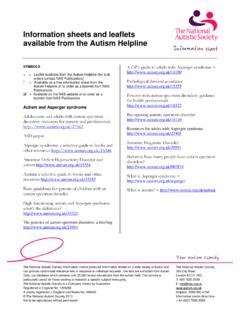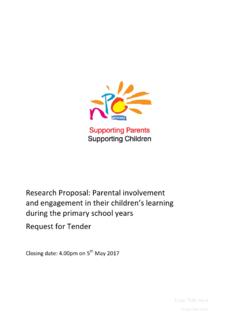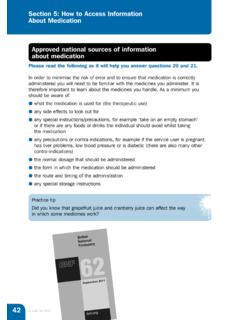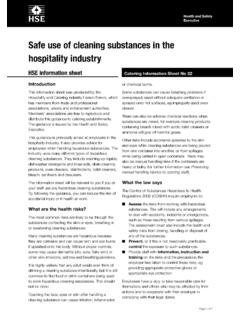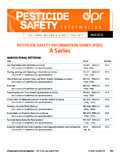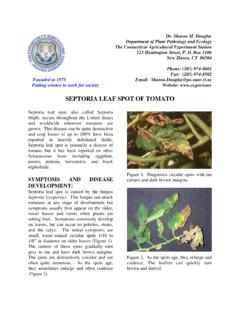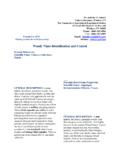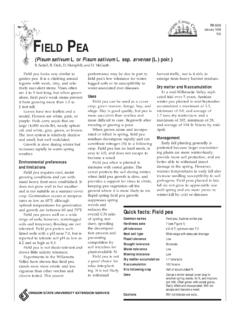Transcription of Planning and preparation - HSE: Information about health ...
1 27 Planning and preparationThis part of the code provides guidance on what you need to consider before using a pesticide tomake sure that you apply it in a way that is safe and effective and meets the relevant Making the risk of using pesticides as low as Considering whether to use a pesticideIt is government policy to keep pesticideuse to the lowest possible level whilemaking sure that pests, diseases andweeds are effectively controlled in a waywhich protects the health of people,plants or creatures you don t intend totreat and the environment. Alwaysconsider whether you need to use apesticide, including pesticide-treatedseed, at all. In many situations you maybe able to prevent or limit pest, diseaseand weed problems by following goodpractices. For example, you may useappropriate crop rotations, differentvarieties of crop, cultivation methods,fertilisers and so on.
2 It is important to tackle a problem assoon as you identify it but before youuse a pesticide you should considerwhether you could tackle the problembetter in other ways (for example, byusing cultural or biological controlmethods or a combination of thesemethods with pesticides, in line withthe principles of integrated cropmanagement and integrated pestmanagement ). An appropriate computer-based system may help you to consider all of the relevant factorsbefore you use a pesticide. You may also find it helpful to use one of the laboratory tests or in-field test kits available to identify a range of crop diseases, or a trap to help monitor insectpests. These methods may help you to decide whether you need to use a pesticide, which oneto use, and the best time to use it. The Defra booklet Pesticides and integrated farm management gives more guidance onintegrated crop management and integrated pest management.
3 You can also get moreinformation from Linking Environment and Farming (contact details in annex B). Section 3 Photograph Crown Copyright, courtesy of the Central Science Laboratory28 Using pesticides when you don t need to is not just a waste of money, it can also contribute topests building up a resistance to products which then become less effective in the future. Youshould always: use a pesticide in a carefully planned way; know the principles of using pesticides over the long term; and consider the long-term implications whenever you use a What to do if you decide that you need to use a pesticide If, after considering all the alternatives, you decide that you need to use a pesticide, there are stilla number of ways in which you can keep any unwanted effects of a pesticide as low as possible. For the pesticide to be as effective as possible it is essential that you use the correctproduct at the right time and in the right way.
4 Always use a product in line with its approved conditions of use. Always consider if youcan use a dose which is lower than the maximum dose allowed by the product label. Youshould think carefully about whether lowering the dose might have an effect on managingpesticide resistance. You may need to get professional advice to decide on the appropriatedose for your situation. In some situations, you may be able to apply the lowest possible amount of pesticide by bettertargeting. For example, by: applying the product as a spot, patch or varied-dose treatment, possibly using GPS (globalpositioning satellite) mapping techniques or optical sensing (see glossary 1 in annex C) ofweeds on hard surfaces; or using weed wipers to apply some herbicides in grassland and similar situations, if theapproved conditions of use allow this, to treat only the relevant vegetation.
5 In all situations, consider the effects the product could have on people s health and theenvironment. The COSHH assessment and assessment of risks to the environment may confirmthat the pesticide you have chosen is the most appropriate. However, if you find that usinganother suitable pesticide may involve less risk to people s health or the environment, or is likelyto lead to a lower risk of resistance, you will need to consider your choice range of pests, weeds and diseases have built up resistance to certain pesticides which wereonce effective. It is important that pesticides are used in a way which reduces the build-up ofresistance so the pesticides that are currently available remain effective. To do this you should: use all pesticides as part of a strategy of managing resistance; include non-chemical methods of pest, weed and disease control; consider, where appropriate, future crop rotation, and not just the current crop; and monitor the effectiveness of pesticide treatments and note any potential resistanceproblems.
6 Section 329 Photograph Crown Copyright, courtesy of the Central Science Choosing the right pesticideIt is essential that you choose the right product in each situation. You may find it helpful to use acomputer-based system to help you find the right product. If you are not qualified to choose themost appropriate pesticide, you should consult a suitably qualified adviser who will also be ableto tell you when and how to use the pesticide and what dose to apply. You can get Information on pesticide resistance and the work of the various resistance actiongroups (RAGs) dealing with fungicides (FRAG), weeds (WRAG), insecticides (IRAG) androdenticides (RRAG) on the PSD website ( ).You can also get advice on resistance management from some product labels and fromadvisers and pesticide manufacturers. Planning and preparation30 When discussing your pesticide needs witha supplier, distributor or adviser, checkwhether the product: is currently approved for theintended use and situation; can be safely prepared and appliedusing the intended equipment; can be used in line with any harvestinterval, access restriction forworkers or livestock, or applicationrestriction (for instance, a bufferzone) shown on the product label; presents the least risk to the healthof people (you and people enteringor living near treated areas) incomparison to other suitablepesticides; presents the least overall risk to livestock, the environment (including surface water andgroundwater) and other creatures (including other biological control agents).
7 And fits in with your strategy for managing product main source of Information that helps you to use a pesticide safely and effectively isthe product label. This must come with the product container at the time you are supplied withthe product. The label is normally permanently fixed to the container but, for some products,detachable or separate leaflets will be Other informationOther relevant Information may come from your supplier and can include the following: Material safety data sheets (MSDS). These have important Information on what to do inan emergency though this Information often also appears on the product label formany products; For many amenity products, Information cards that can be given to members of the publicwho ask about the product; and Environmental Information sheets (EIS) are available for many products to add to theinformation on the product label about the risks to the environment and how tocontrol may want to check the Voluntary Initiative website ( ) to seewhat Information you can Checking the approvalYou cannot assume that a product you have used before is still approved as a suitable productor for a particular use.
8 This is because product approvals are frequently changed. You mustespecially check approvals for commodity substances (see glossary 1 in annex C), off-label usesor imported pesticides identical to products already approved in the UK. These approvals are thebest Information available on using the you are not sure, up-to-date Information on approval status is available on the PSD website( ). You should check for the UK approval status of any foreign pesticide before you buy it. Unlessthe product is approved in the UK you will be committing an offence if you store and use aforeign product, even if an English label is supplied with The labelAll labels have the phrase Read all safety precautions and directions for use before use . It isessential that you read and understand all the Information contained in the label (and any leafletssupplied with the product).
9 Only by doing so will you be able to use the pesticide safely andeffectively, taking account of the specific proposedtreatment and the circumstances and environmentalconditions. By law you must take all reasonableprecautions when using pesticides. To do this youmust consider the label as a whole and make ajudgement about the equipment and how youintend to use the reading a product label, the most importantparts to consider are protecting you, protecting theenvironment, protecting consumers, storage anddisposal, and medical advice. Some of these factorson the label will apply to more than one of Protecting you and others around you checkwhether the label says anything about : the need to carry out a COSHH assessment,as appropriate; the need to use engineering controls (forexample, closed cabs when making air-assistedapplications); the need to use specific personal protective equipment (PPE); any medical conditions which may be made worse (for example, when intending to use aproduct containing an organophosphate or a carbamate with anticholinesterase effects see glossary 1 in annex C); Planning and preparation32 the need for treated areas to be ventilated after treatment before re-entry and/or entry tobe prevented for set periods of time; and other safety measures such as: cleaning the PPE.
10 What to do if someone is contaminated; the need for any specialised training; good hygiene practice; and using refillable Protecting the environment check whether the label says anything about : not using the product outside; the need for keeping the areas out of bounds after treatment to protect livestock; removing or burying spillages; the need for buffer zones to protect water, and whether they can be reduced by LERAP assessments; the need for buffer zones to protect insects and other creatures you don t intend to treat; the need to remove pets and livestock before use or to keep animals and birds out of thetreatment area; and protecting bees by not treating flowering consumers check whether the label says anything about : not using the product on food crops, in food storage or preparation areas or in occupiedbuildings; the maximum dose or maximum concentration for some products applied as high-volumesprays; the maximum number of treatments or maximum total dose; the latest time that the product can be used depending on the crop-growth stage orharvest interval; and other specific restrictions (for example, the maximum concentration of the product in thespray solution or the minimum water volume, the minimum interval between applicationsorrestrictions on using certain types of equipment to apply the product).










